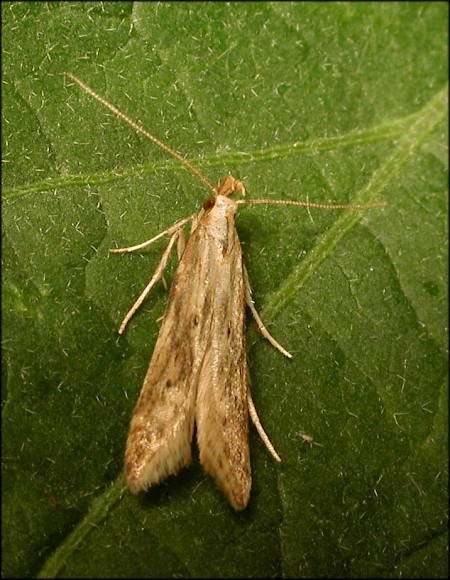35.056 BF724
Metzneria lappella
(Linnaeus, 1758)
Wingspan 16-20 mm.
Occurring sometimes commonly in southern England and in the north of England and Wales, but local in Scotland and unknown in Ireland.
The larvae feed on the seeds of greater burdock (Arctium lappa), and pupation takes place in the seedhead.
The adults fly in June and July.
- Larva: (description Ian F. Smith):
Foodplant: September to April, in seeds of Arctium lappa and A. minus.
Length: 4.5 mm - 5 mm in January.
Head: Brown ochre, except for whitish vertical triangle joined to broad whitish band bordering the upper frons, continuing as a thin whitish line bordering the lower frons. The band is sometimes expanded laterally into a triangular mark. Posterior of brown ochre parts of head thinly edged by darker brown, widening slightly to terminate as a small dark postero-lateral mark. Frons brown ochre edged by reddish brown on all three sides. Mandibles reddish brown with dark teeth. Stemmata colourless. Stemmatal area blackish, extending anteriorally beyond stemmata.
Prothoracic shield: Transparent yellowish white, showing brown when head withdrawn below it. Unmarked, or with a few distinct brown spots along edge of indistinct whitish medial line.
Thoracic legs: Concolorous with body. Vestigial.
Body: Squat. Prominently segmented. Translucent whitish.
Spiracles: Small. Peritreme burnt ochre.
Pinacula: None discernible.
Setae: Fine, transparent colourless.
Anal plate: Concolorous with body.
Prolegs: Obsolete, except for a pair of vestigial anal prolegs clasped together.
Comments: To find larvae in winter, open seedheads of Arctium. Most seeds will separate easily, but if a group of about seven adhere to each other they are likely to contain the hibernaculum of M. lappella. Carefully break the seeds apart. The hibernaculum is a horizontal tube of thin dirty white silk which penetrates the sides of the vertical seeds, pinning them together. It may pass through between two to seven seeds. Early stages may only occupy one seed, and be betrayed by the circular entrance hole.
Arctium seed heads adhere tightly to clothing and bare flesh. PVC work gloves and waterproofs prevent this problem. Collecting lengths of stem with the seed heads attached makes subsequent processing easier.

 UKMoths
UKMoths 



